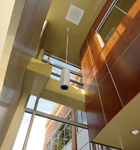At a Glance
Location
Boca Raton, FL
Founded
2007
Employees
6–7
Specialty
Modular architectural technology solutions
In the modern workspace, employee numbers grow and shrink, technology evolves and must be updated, and demands on space shift with both. Yet even with the rapid evolution of smart buildings and intelligent design, says Hagan Freeman, president of Modular Interior Technologies, LLC (MIT), flexible power and data solutions are often viewed less strategically and less often than other building components in the United States. MIT, a design, install, and service-turnkey operation founded in 2007, hopes to address this problem.
“As we’ve all heard before,” Freeman says, “the only constant is change.” Businesses need to be able to manage this change, so MIT’s strategy is to shift central energy and data command from unwieldy power poles and ceiling cables to a grid-based plug-and-play floor, a system manufactured by Kiva. These modular, raised-access platforms provide zoned wall-to-wall cable management while Portland cement tiling protects the pathways beneath. These pathways are formed in the spaces between Cablefloor support cylinders, and each can hold up to 100 category 5e cables, meaning 400 cables can run beneath each 2’ x 2’ tile.
Top 5 Products from Modular Interior Technologies
1. Kiva’s Cablefloor system, an inflammable, moisture-resistant product made of Portland cement and wood fiber, measures two and a half inches in height and has a load-bearing capacity of 45,000 pounds per square foot.
2. Trendway’s TrendWall is the industry’s first carbon-neutral architectural wall product.
3. Mohawk/Bigelow offers modular carpet tiles in environmentally friendly designs for traditional office spaces.
4. Oscoda Plastics’s ESD, rubber, and vinyl tiles are 100% recycled and can be used in spaces that require tile finishes, such as data centers and server rooms.
5. H.H. Robertson’s cellular duct systems enclose the subfloor cabling and protect it from fire.
With a load-bearing capacity of 45,000 pounds per square foot, the two-and-a-half-inch-thick floor is strong and designed with open office environments in mind, allowing its users to quickly and easily adapt to changing spatial needs. Also, rather than forcing clients to arrange separate service appointments with electricians, data contractors, and furniture movers (and then everyone again, in reverse order) to reconfigure an office space, MIT does the whole job—ideally in less time and with fewer disruptions. “It’s just a more efficient method,” Freeman says. “We can do it in a day.”
With more than 30 years of experience in the electrical and data-communications fields, Freeman is now able to move beyond the merely technical to address other shape-shifting aspects of workplace interiors. MIT offers a selection of movable and demountable TrendWall systems (prefabricated, freestanding panels fitted into tracks along the ceilings and floors) and recycled-content floor finishes (in carpet, rubber, and vinyl options). And the eco-friendliness of Freeman’s products is underscored by the inherent sustainability of the modular systems themselves: they allow flexibility in any space in which they are installed, yes, but they can also be removed and placed at another site entirely without any equipment going to waste.
Modular systems are often perceived as more costly than their traditional counterparts, but Freeman argues that Cablefloor costs less than other communications systems outright and that modular wall systems make economical sense in the long run. He points to change orders and other inefficiencies in current building processes—expenses that can be avoided with a modular approach—as problems his operation can solve. “And look at life cycle costs, too,” Freeman says. “Even if you [reconfigure the space] once, you have return on investment.”
MIT’s high-profile clients include the Special Operations Command at MacDill Air Force Base and Liberty Medical, and Freeman also works with smaller clients such as Sarasota’s Riverview High School and the University of Central Florida. Recently, the company installed 300 feet of demountable wall for the Students Services Building at Edison State College. Despite all this, though, education about the company is still the primary challenge to MIT’s growth. “The line I hear the most is, ‘I wish we’d known about this a month ago,’” Freeman says. But he also doesn’t seem to feel the least bit defeated. “Modular technologies will become the way buildings are built in the future, though,” he says. “It’s the inevitable next step.” ABQ


